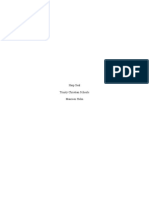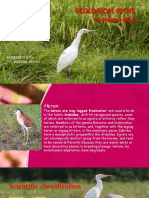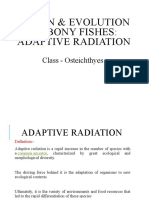0 ratings0% found this document useful (0 votes)
70 viewsPinniped
Pinniped
Uploaded by
Sandri Alexandra NegreanuPinnipeds are a diverse group of semiaquatic marine mammals that includes three main families: seals, sea lions, and walruses. They have streamlined bodies and flippers adapted for swimming. While they spend most of their time in water, they come onto land to rest, give birth, and molt. Pinnipeds have a layer of blubber and fur to keep warm in cold waters.
Copyright:
© All Rights Reserved
Available Formats
Download as DOCX, PDF, TXT or read online from Scribd
Pinniped
Pinniped
Uploaded by
Sandri Alexandra Negreanu0 ratings0% found this document useful (0 votes)
70 views4 pagesPinnipeds are a diverse group of semiaquatic marine mammals that includes three main families: seals, sea lions, and walruses. They have streamlined bodies and flippers adapted for swimming. While they spend most of their time in water, they come onto land to rest, give birth, and molt. Pinnipeds have a layer of blubber and fur to keep warm in cold waters.
Original Description:
Pinniped
Copyright
© © All Rights Reserved
Available Formats
DOCX, PDF, TXT or read online from Scribd
Share this document
Did you find this document useful?
Is this content inappropriate?
Pinnipeds are a diverse group of semiaquatic marine mammals that includes three main families: seals, sea lions, and walruses. They have streamlined bodies and flippers adapted for swimming. While they spend most of their time in water, they come onto land to rest, give birth, and molt. Pinnipeds have a layer of blubber and fur to keep warm in cold waters.
Copyright:
© All Rights Reserved
Available Formats
Download as DOCX, PDF, TXT or read online from Scribd
Download as docx, pdf, or txt
0 ratings0% found this document useful (0 votes)
70 views4 pagesPinniped
Pinniped
Uploaded by
Sandri Alexandra NegreanuPinnipeds are a diverse group of semiaquatic marine mammals that includes three main families: seals, sea lions, and walruses. They have streamlined bodies and flippers adapted for swimming. While they spend most of their time in water, they come onto land to rest, give birth, and molt. Pinnipeds have a layer of blubber and fur to keep warm in cold waters.
Copyright:
© All Rights Reserved
Available Formats
Download as DOCX, PDF, TXT or read online from Scribd
Download as docx, pdf, or txt
You are on page 1of 4
Pinniped
From Wikipedia, the free encyclopedia
Pinnipeds
Temporal range: Oligocene Holocene, 240Ma
Pre
O
S
D
C
P
T
J
K
Pg
N
Clockwise from top: New Zealand fur
seal(Arctocephalus forsteri), Southern elephant
seal(Mirounga leonina), Steller sea lion (Eumetopias
jubatus), Walrus (Odobenus rosmarus) and Grey
seal(Halichoerus grypus)
Scientific classification
Kingdom: Animalia
Phylum: Chordata
Class: Mammalia
Order: Carnivora
Suborder: Caniformia
Infraorder: Arctoidea
(unranked): Pinnipedimorpha
Clade: Pinnipedia
Illiger, 1811
[1]
Subgroups
Family Enaliarctidae
Superfamily Otarioidea
Family Odobenidae (walruses)
Family Otariidae (fur seals and sea
lions)
Superfamily Phocoidea
Family Phocidae (true seals)
Family Desmatophocidae
Range map
Pinnipeds (/pnpdz/), colloquially known as seals,
[a]
are a widely distributed and
diverse clade of fin-footed, semiaquaticmarine mammals. They comprise
the extant families Odobenidae (whose only living member is the walrus), Otariidae (the
eared seals: sea lions and fur seals), and Phocidae (the earless, or true seals). There
are 33 extant species of pinnipeds, and more than 50 extinct species have been
described from fossils. While seals were historically thought to have descended from two
ancestral lines, molecular evidence supports them as a monophyletic lineage
(descended from one ancestral line). Pinnipeds belong to the order Carnivora and their
closest living relatives are bears and musteloids (weasels, raccoons andskunks).
Seals range in size from the 1 m (3 ft 3 in) and 45 kg (99 lb) Baikal seal to the 5 m (16 ft)
and 3,200 kg (7,100 lb) southern elephant seal, which is also the largest
carnivoran.
[b]
Several species exhibit sexual dimorphism. They have streamlined bodies
and four limbs that are modified into flippers. Though not as fast in the water as dolphins,
seals are more flexible and agile. Otariids use their front limbs primarily to propel
themselves through the water, while phocids and walruses use their hind limbs. Otariids
and walruses have hind limbs that can be pulled under the body and used as legs on
land. By comparison, terrestrial locomotion by phocids is more cumbersome. Otariids
have visible external ears, while phocids and walruses lack these. Pinnipeds have well-
developed sensestheir eyesight and hearing are adapted for both air and water, and
they have an advanced tactile system in their whiskers or vibrissae. Some species are
well adapted for diving to great depths. They have a layer of fat, or blubber, under the
skin to keep warm in the cold water, and, other than the walrus, all species are covered
in fur.
Although pinnipeds are widespread, most species prefer the colder waters of the
Northern and Southern Hemispheres. They spend most of their lives in the water, but
come ashore to mate, give birth, molt or escape from predators, like sharks andkiller
whales. They feed largely on fish and marine invertebrates; but a few, like the leopard
seal, feed on large vertebrates, such as penguins and other seals. Walruses are
specialized for feeding on bottom-dwelling mollusks. Male pinnipeds typically mate with
more than one female (polygyny), although the degree of polygyny varies with the
species. The males of land-breeding species tend to mate with a greater number of
females than those of ice- or water-breeding species. Male pinniped strategies
for reproductive success vary between defending females, defending territories that
attract females and performingritual displays or lek mating. Pups are typically born in the
spring and summer months and females bear almost all the responsibility for raising
them. Mothers of some species fast and nurse their young for a relatively short period of
time while others take foraging trips at sea between nursing bouts. Walruses are known
to nurse their young while at sea. Seals produce a number of vocalizations, notably the
barks of California sea lions, the gong-like calls of walruses and the complex songs
ofWeddell seals.
The meat, blubber and fur coats of pinnipeds have traditionally been used by indigenous
peoples of the Arctic. Seals have been depicted in various cultures worldwide. They are
commonly kept in captivity and are even sometimes trained to perform tricks and tasks.
Once relentlessly hunted by commercial industries for their products, seals are now
protected by international law. The Japanese sea lion and the Caribbean monk seal have
become extinct in the past century, while the Mediterranean monk seal and Hawaiian
monk seal are ranked Critically Endangered by the International Union for Conservation
of Nature. Besides hunting, pinnipeds also face threats from accidental trapping, marine
pollution, and conflicts with local people.
Contents
[hide]
1 Taxonomy
o 1.1 Evolutionary history
2 Anatomy and physiology
o 2.1 Locomotion
o 2.2 Senses
o 2.3 Diving adaptations
o 2.4 Thermoregulation
o 2.5 Sleep
3 Distribution and habitat
4 Behavior and life history
o 4.1 Foraging and predation
o 4.2 Reproductive behavior
o 4.3 Birth and parenting
o 4.4 Communication
o 4.5 Intelligence
5 Human relations
o 5.1 Cultural depictions
o 5.2 In captivity
o 5.3 Conservation and management issues
6 Notes
7 References
o 7.1 Bibliography
8 External links
You might also like
- Autopsy Report, Brittany MurphyDocument0 pagesAutopsy Report, Brittany MurphySandri Alexandra Negreanu7% (14)
- At The Zoo The Thinking TrainDocument3 pagesAt The Zoo The Thinking TrainCinthya Ximena Perez Garcia0% (1)
- 10 AAU - Level 3 - Test - Challenge - Unit 1Document4 pages10 AAU - Level 3 - Test - Challenge - Unit 1ireneNo ratings yet
- The Origin and Evolutionary Biology of Pinnipeds Seals, Sea Lions, and WalrusesDocument26 pagesThe Origin and Evolutionary Biology of Pinnipeds Seals, Sea Lions, and WalrusesMaya D.No ratings yet
- Pinnels ResearchDocument1 pagePinnels Researchcelesis600No ratings yet
- Pinniped: From Wikipedia, The Free EncyclopediaDocument7 pagesPinniped: From Wikipedia, The Free EncyclopediaLak DavisNo ratings yet
- Marine BiologyDocument25 pagesMarine Biologyapi-348512756No ratings yet
- From Wikipedia-Not My Knowledge: Whale Is The: FusiformDocument2 pagesFrom Wikipedia-Not My Knowledge: Whale Is The: FusiformotiliaNo ratings yet
- Whales Are A Widely Distributed and Diverse Group of Fully AquaticDocument2 pagesWhales Are A Widely Distributed and Diverse Group of Fully AquaticmmjpgcilNo ratings yet
- Whales Are A Widely Distributed and Diverse Group ofDocument2 pagesWhales Are A Widely Distributed and Diverse Group ofSean CNo ratings yet
- Sea TurtlesDocument12 pagesSea TurtlesHeiseth OcamposNo ratings yet
- Marine MammalsDocument38 pagesMarine MammalsleofhenelseguizaNo ratings yet
- Bio 3202 Lab Exercise No. 10Document14 pagesBio 3202 Lab Exercise No. 10nicole john forroNo ratings yet
- Killer Whales Thesis StatementDocument5 pagesKiller Whales Thesis Statementafcnoxdhv100% (2)
- Marine MammalsDocument16 pagesMarine MammalsKogulan MuruganNo ratings yet
- Handouts VertebratesDocument5 pagesHandouts VertebratesDiane PamanNo ratings yet
- AnswerkeyDocument2 pagesAnswerkeyapi-320872763No ratings yet
- Phil Wildlife Jan 10, 2012 NotesDocument15 pagesPhil Wildlife Jan 10, 2012 NotesAbigail CuyacotNo ratings yet
- TurtlesDocument2 pagesTurtlesnic jNo ratings yet
- Dolphin - WikipediaDocument52 pagesDolphin - WikipediaKimberly WongNo ratings yet
- Final Bio FactexpressDocument3 pagesFinal Bio FactexpressLaila Istighfaroh Ella EllEllNo ratings yet
- Europe / What We Do / Why Are We Being Invaded by Jellyfish?Document5 pagesEurope / What We Do / Why Are We Being Invaded by Jellyfish?Zabrina VegaNo ratings yet
- Klasifikasi VertebrataDocument13 pagesKlasifikasi VertebrataFony Pellokila SinlaeNo ratings yet
- Marine Biology Irs - Marine MammalsDocument11 pagesMarine Biology Irs - Marine MammalsMaureen HelmNo ratings yet
- PerezDocument9 pagesPerezHeizyl ann VelascoNo ratings yet
- Vertebrate ClassificationDocument5 pagesVertebrate Classificationaneesh sebastianNo ratings yet
- Anura (: (Hide)Document4 pagesAnura (: (Hide)kbarn389No ratings yet
- ANNIMALIADocument14 pagesANNIMALIAdacubaelisa19No ratings yet
- AnimalDocument22 pagesAnimalJudin BellNo ratings yet
- For Other Uses, See .: Frog (Disambiguation)Document6 pagesFor Other Uses, See .: Frog (Disambiguation)Mari Creon A. BaumgardnerNo ratings yet
- Bony FishesDocument70 pagesBony FishesJigar PatelNo ratings yet
- Frogs, Sharks, WhalesDocument8 pagesFrogs, Sharks, Whalesharshv75No ratings yet
- FROGDocument1 pageFROGKidMonkey2299No ratings yet
- CatfishesDocument9 pagesCatfishesrituNo ratings yet
- OrcasorkillerwhalesDocument3 pagesOrcasorkillerwhalesapi-285768106No ratings yet
- Fish As Food Fish (Disambiguation) VertebrataDocument15 pagesFish As Food Fish (Disambiguation) VertebrataGemlyn de CastroNo ratings yet
- Bottlenose Dolphin: Kingdom: Phylum: Class: Order: FamilyDocument2 pagesBottlenose Dolphin: Kingdom: Phylum: Class: Order: Familyrudiskw456No ratings yet
- Let’s Explore WhalesDocument13 pagesLet’s Explore WhalesMinhaj AijazNo ratings yet
- Biology 10 Performance Task #3: Shelly Marie L. de La Cruz 10-LaurenciumDocument20 pagesBiology 10 Performance Task #3: Shelly Marie L. de La Cruz 10-LaurenciumShelly Marie De la CruzNo ratings yet
- Dolphin Fact SheetDocument2 pagesDolphin Fact Sheetapi-247924430100% (1)
- Whales Are A Widely Distributed and Diverse Group of Fully: FusiformDocument1 pageWhales Are A Widely Distributed and Diverse Group of Fully: Fusiformaashikapriya3037No ratings yet
- Animals: Cells Eukaryotic CellsDocument17 pagesAnimals: Cells Eukaryotic CellsFallianda YandaNo ratings yet
- Name: Alvear Samantha Year Basic: Third C Topic: Lion Fish Definition Group: 1Document25 pagesName: Alvear Samantha Year Basic: Third C Topic: Lion Fish Definition Group: 1Priscila Aguilar AvellánNo ratings yet
- Rogs Are A Diverse and LargelyDocument1 pageRogs Are A Diverse and LargelygordonskllllNo ratings yet
- Presentor: Alyanna D. de Leon Beed-1EDocument36 pagesPresentor: Alyanna D. de Leon Beed-1EAly D. De LeonNo ratings yet
- Amphibians 1Document11 pagesAmphibians 1mwanyemiwistonNo ratings yet
- Biology 2004Document41 pagesBiology 2004SciOlympiad2345100% (2)
- Survey of AmphibiansDocument35 pagesSurvey of AmphibiansAeriel Venice VergaraNo ratings yet
- invertibraeDocument10 pagesinvertibraemknightNo ratings yet
- CatfishDocument21 pagesCatfishJozel Margarette CruzNo ratings yet
- GullDocument14 pagesGulljosh321No ratings yet
- Tahap-Tahap Evolusi IkanDocument11 pagesTahap-Tahap Evolusi IkanGunawan Muhammad100% (1)
- From Wikipedia, The Free Encyclopedia Jump To:, For Other Uses, SeeDocument5 pagesFrom Wikipedia, The Free Encyclopedia Jump To:, For Other Uses, SeefrndgurlNo ratings yet
- Starfish: Starfish or Sea Stars Are Star-Shaped Echinoderms Belonging To The Class AsteroideaDocument2 pagesStarfish: Starfish or Sea Stars Are Star-Shaped Echinoderms Belonging To The Class AsteroideaAWahyoon-i Theeyass0% (1)
- Starfish: Starfish or Sea Stars Are Star-Shaped Echinoderms Belonging To The Class AsteroideaDocument2 pagesStarfish: Starfish or Sea Stars Are Star-Shaped Echinoderms Belonging To The Class AsteroideaAWahyoon-i TheeyassNo ratings yet
- Classification of Marine OrganismsDocument4 pagesClassification of Marine OrganismsdrsnsureshNo ratings yet
- Crocodile (Reptile) - EncartaDocument1 pageCrocodile (Reptile) - Encartaxxxbilly1986xxxNo ratings yet
- Horseshoe Crab: Limulidae Horseshoe Crabs Are Marine and Brackish Water Arthropods of TheDocument9 pagesHorseshoe Crab: Limulidae Horseshoe Crabs Are Marine and Brackish Water Arthropods of Theenzo abrahamNo ratings yet
- Chapter 2 Snakes of Papua New GuineaDocument23 pagesChapter 2 Snakes of Papua New GuineaIrfan Haidar BasyirNo ratings yet
- Learning about Fish and Mammal Species | Children's Fish & Marine LifeFrom EverandLearning about Fish and Mammal Species | Children's Fish & Marine LifeNo ratings yet
- Frog Legs: ProductDocument4 pagesFrog Legs: ProductSandri Alexandra NegreanuNo ratings yet
- Recipe Fried Frog Legs PDFDocument1 pageRecipe Fried Frog Legs PDFSandri Alexandra NegreanuNo ratings yet
- Scope Vet Assistant Duties PDFDocument70 pagesScope Vet Assistant Duties PDFSandri Alexandra NegreanuNo ratings yet
- Confidentcookingwithbeef PDFDocument25 pagesConfidentcookingwithbeef PDFSandri Alexandra NegreanuNo ratings yet
- Vegetarian Vegan Recipe BookDocument68 pagesVegetarian Vegan Recipe BookJerry DoughertyNo ratings yet
- JH Family Butcher Recipe E Bookv3 PDFDocument50 pagesJH Family Butcher Recipe E Bookv3 PDFSandri Alexandra NegreanuNo ratings yet
- Glorious PDFDocument47 pagesGlorious PDFSandri Alexandra NegreanuNo ratings yet
- Kid-Friendly Beef Recipes: For More Great Recipes, VisitDocument11 pagesKid-Friendly Beef Recipes: For More Great Recipes, VisitSandri Alexandra NegreanuNo ratings yet
- Ingredients For Brave and Bold Beef StewDocument4 pagesIngredients For Brave and Bold Beef StewSandri Alexandra NegreanuNo ratings yet
- CMC Veterinary Technology Program Handbook PDFDocument38 pagesCMC Veterinary Technology Program Handbook PDFSandri Alexandra NegreanuNo ratings yet
- A New Beef Guide With RecipesDocument148 pagesA New Beef Guide With RecipesNisa33% (3)
- Ground Beef Recipes 25 Quick and Easy Recipes For Ground Beef PDFDocument31 pagesGround Beef Recipes 25 Quick and Easy Recipes For Ground Beef PDFSandri Alexandra Negreanu100% (4)
- Forensic PathologyDocument5 pagesForensic PathologySandri Alexandra NegreanuNo ratings yet
- German ShepherdDocument6 pagesGerman ShepherdSandri Alexandra NegreanuNo ratings yet
- Habitat: Estrildid Finch Central Australia Indonesia East Timor Puerto Rico Portugal BrazilDocument6 pagesHabitat: Estrildid Finch Central Australia Indonesia East Timor Puerto Rico Portugal BrazilSandri Alexandra NegreanuNo ratings yet
- Veterinary Technology Program Handbook: 2019 Laguardia Community CollegeDocument24 pagesVeterinary Technology Program Handbook: 2019 Laguardia Community CollegeSandri Alexandra NegreanuNo ratings yet
- Fatal FriendshipDocument30 pagesFatal FriendshipSandri Alexandra Negreanu100% (1)
- Zebra Finch AggressionDocument10 pagesZebra Finch AggressionSandri Alexandra NegreanuNo ratings yet
- Watermark PSDocument1 pageWatermark PSSandri Alexandra NegreanuNo ratings yet
- Report TextDocument6 pagesReport TextJahrudin AudreyNo ratings yet
- Group 2 Report TextDocument10 pagesGroup 2 Report TextRiska Nadiya X MIPA 2No ratings yet
- Blue Whale Interesting FactsDocument16 pagesBlue Whale Interesting FactsWajid AliNo ratings yet
- General Description: Loudest Animal On Earth Plankton Krill BaleenDocument5 pagesGeneral Description: Loudest Animal On Earth Plankton Krill BaleenKishan PatelNo ratings yet
- Actual Reading 38Document91 pagesActual Reading 38Smita R. S.No ratings yet
- AmbulocetusDocument3 pagesAmbulocetusEmilio Lecaros BustamanteNo ratings yet
- Wee Sing and Learn 1 2 3 (Song Lyrics) : Under The SeaDocument5 pagesWee Sing and Learn 1 2 3 (Song Lyrics) : Under The SeaClaudia PalmaNo ratings yet
- ICELAND ITINERARY (23-27/5/16) - Viet Nga Nguyen: Plan TimeDocument3 pagesICELAND ITINERARY (23-27/5/16) - Viet Nga Nguyen: Plan TimeSlice LeNo ratings yet
- Captive Killer Whales (Orcas) Separated From Their MothersDocument1 pageCaptive Killer Whales (Orcas) Separated From Their MothersThe Orca Project Corp100% (1)
- AnswerkeyDocument2 pagesAnswerkeyapi-320872763No ratings yet
- Pinniped: PinnipedsDocument20 pagesPinniped: Pinnipedsjosko jokicNo ratings yet
- SealszoobookDocument10 pagesSealszoobookapi-239364834100% (1)
- WhalesDocument5 pagesWhalesSalma BazziNo ratings yet
- Dolphin EncyclopediaDocument27 pagesDolphin EncyclopediaAmy KlezanNo ratings yet
- Expert Book NarwhalsDocument14 pagesExpert Book Narwhalsapi-276209074No ratings yet
- Whales and DolphinsDocument3 pagesWhales and Dolphinsapi-354891511No ratings yet
- Report Text: DolphinDocument2 pagesReport Text: DolphinRirin Sri OktavianiNo ratings yet
- Dolphin PDFDocument39 pagesDolphin PDFenzo abrahamNo ratings yet
- Dolphin Fact SheetDocument2 pagesDolphin Fact Sheetapi-247924430100% (1)
- Whale Evolution Date Table Name: Asia and Europe 60-37 Mya. ShoreDocument2 pagesWhale Evolution Date Table Name: Asia and Europe 60-37 Mya. ShoreGracielle De Torres CaparasNo ratings yet
- A Guide To The Pronunciation and Meaning of Cetacean Taxonomic NamesDocument13 pagesA Guide To The Pronunciation and Meaning of Cetacean Taxonomic NamesLeonardo LopesNo ratings yet
- Comments On My PetitionDocument15 pagesComments On My PetitionMelanieBarrettNo ratings yet
- Basic Facts About Beluga WhalesDocument2 pagesBasic Facts About Beluga WhalesSyaiul KiramNo ratings yet
- Polar Bears: © Primary Leap Ltd. 2012 WWW - Primaryleap.co - Uk - Primary ResourcesDocument2 pagesPolar Bears: © Primary Leap Ltd. 2012 WWW - Primaryleap.co - Uk - Primary ResourcesBrinzea LauraNo ratings yet
- Evolution of WhalesDocument15 pagesEvolution of WhalesSanjanaSureshNo ratings yet
- Correlative Conjunction TestDocument1 pageCorrelative Conjunction TestAyu SeptianaNo ratings yet
- ReadingI1001 - Attempt ReviewDocument13 pagesReadingI1001 - Attempt ReviewThuý HuỳnhNo ratings yet











































































































